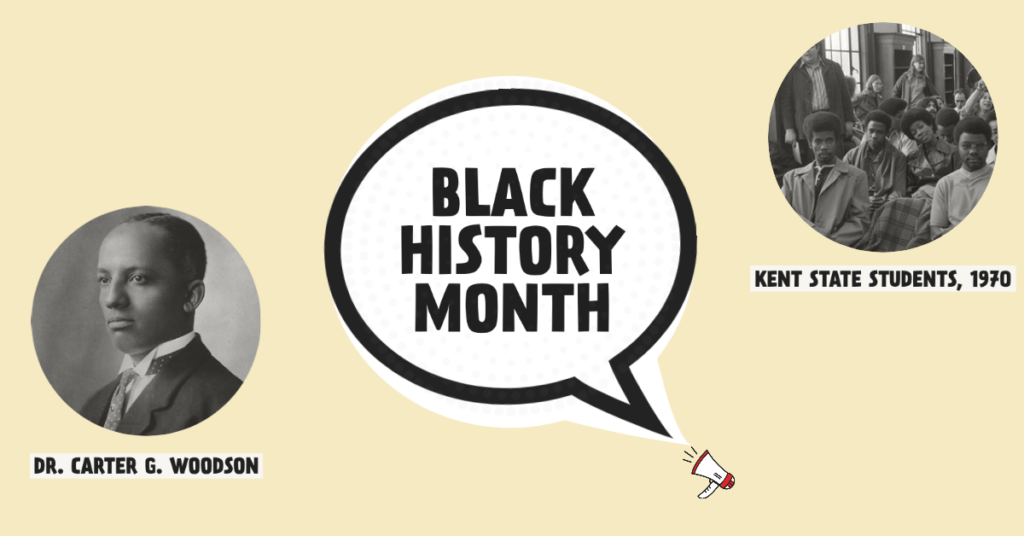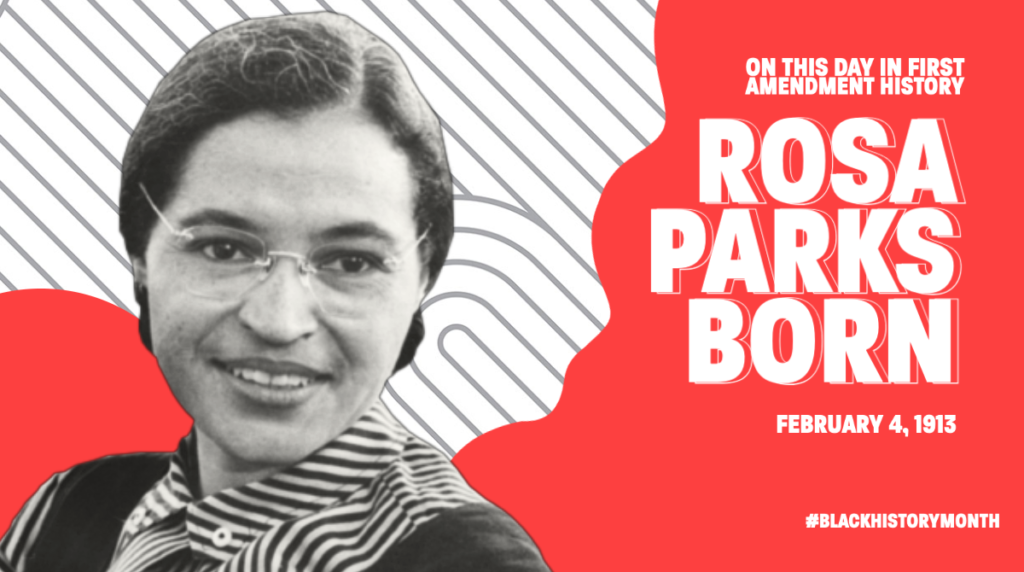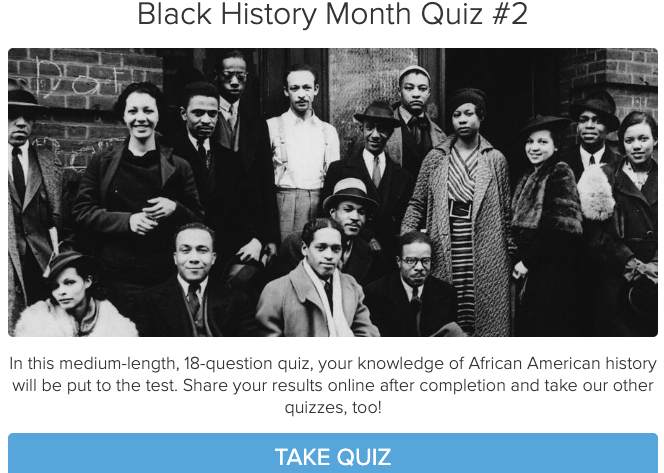Black History Month in 2021
While the Museum recognizes black history every month, in February we especially highlight the lives and actions of African Americans who used their First Amendment freedoms to contribute to our American fabric.
Throughout this month, we will be posting activities and events that will amplify black voices and experiences, and increase your knowledge of our nation’s history.
Black History Month’s origins
Black History Month began as Negro History Week in 1926 and was initiated by Dr. Carter G. Woodson, founder of what is today known as the Association for the Study of African American Life and History (ASALH), as a way to teach about African Americans’ contributions to society.
Over the following decades, the tradition grew and in 1970 the first Black History Month celebration officially took place at Kent State. Fifty years after it began, during the bicentennial celebration of 1976, President Gerald Ford announced that Black History Month was an officially recognized holiday, stating that Americans should “seize the opportunity to honor the too-often neglected accomplishments of Black Americans in every area of endeavor throughout our history.”
2/1/1960 – Lunch counter Sit-In
2/1/1960 – On this day in First Amendment History, the first sit-in at Woolworth’s lunch counter took place in Greensboro, N.C. when four black college students took seats at an all-white lunch counter in the segregated department store. After being refused service, the four students refused to leave, and police and media were called to the scene. Over the next few days, the students returned with an ever-increasing number of protestors; less than a week later, 1,000 students packed into the Woolworth’s.
While their sit-in was not the first (nor the last) of its kind during the Civil Rights movement, it certainly gained traction and media attention, and variations occurred in cities throughout the south. The Greensboro Woolworth’s finally desegregated 5 months later after incurring massive financial losses, but it took another 5 years of protest before the Civil Rights Act of 1965 was passed, mandating desegregation.
Today, you can visit the original site of the Greensboro Woolworth’s sit-in by visiting the International Civil Rights Center & Museum
Black History Month – Quiz 1
Test your knowledge of African American history by taking our short quiz. Don’t forget to share your results!
2/4/1913 – Rosa Parks is born
2/4/1913 – On this day in First Amendment History, Rosa Parks was born.
Perhaps one of the most famous figures from the Civil Rights Movement, Rosa Parks made national headlines in 1955 when she refused to give up her seat to a white man on a bus in Montgomery, Alabama.
Rosa was arrested for – and later convicted of – breaking Montgomery city code, which stated that the front rows on a bus were reserved for white passengers, while black passengers had to sit in the back. In reaction to her arrest, the black community initiated the Montgomery Bus Boycott.
More than a year later, the Supreme Court ruled that bus segregation was unconstitutional.
In her 1992 autobiography, Rosa wrote: “People always say that I didn’t give up my seat because I was tired, but that isn’t true. I was not tired physically… No, the only tired I was, was tired of giving in.”
Video: “To Make a Poet Black: Notes from a Literary-Musician“
Regie Gibson hosts brings the audience into the creative power of speech in the modern Black spoken-word tradition in an engaging, educational online performance that took place on Thursday, February 4th, 2021.
One on 1 with Noelle Trent
Noelle Trent is the Director of Interpretation, Collections & Education at National Civil Rights Museum. She talks to us about the movement in the wake of George Floyd’s murder, differences between the protests of today and in the ’60s, and how the First Amendment is Americans’ “superpower”.
Black History Month – Quiz #2
Test your knowledge of African American history by taking our medium quiz. Don’t forget to share your results!
2/17/1942 – Huey P. Newton is born
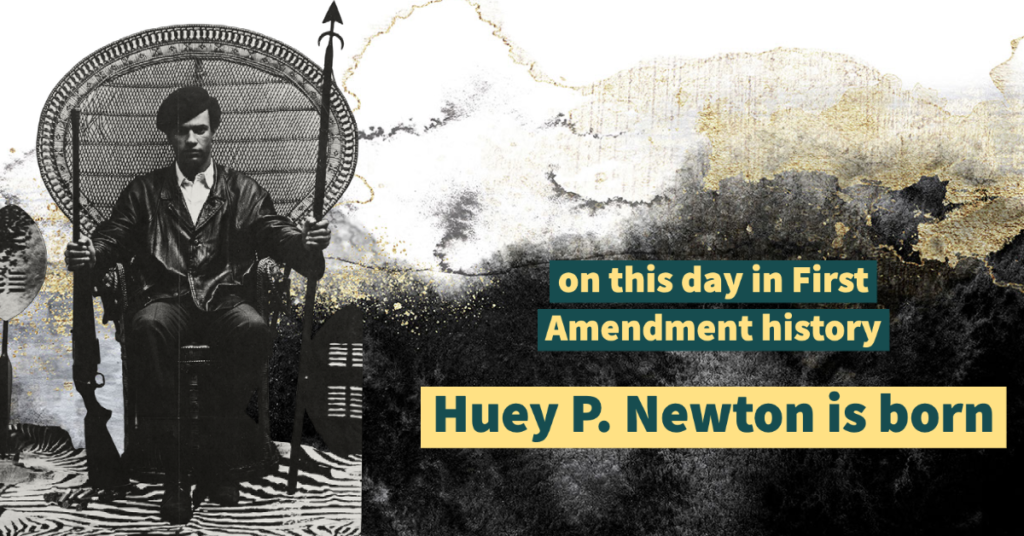
2/17/1942 – On this day in First Amendment history, activist Huey P. Newton was born.
Disappointed with what he saw as failures in the nonviolent civil rights movement, Newton co-founded the Black Panther Party in 1966 in Oakland, CA. Originally called the Black Panther Party for Self Defense, the organization originally provided armed patrols to “copwatch” in black neighborhoods to deter police brutality.
Over time, the Black Panther Party gained chapters throughout the United States, combining the values and ideals of Black nationalism and socialism, and including a strong militant emphasis. Often led by women, the chapters advocated for community reforms and provided free food for children, health clinics for the sick, legal aid, and other services for disenfranchised communities suffering from economic and social inequality.
Throughout the ‘70s and into the early ‘80s, the Black Panther Party’s power diminished after being targeted by the FBI, party in-fighting, and negative public perceptions of party violence. Newton was assassinated in 1989 by a member of the Black Guerilla Family.
If you’d like to learn more about the Black Panther Party – including how the FBI COINTELPRO’s program contributed to its demise – watch “Judas and the Black Messiah” – a new release on HBO. The film is based on the true story of an FBI informant who infiltrated the Chicago chapter of the Black Panther Party led by Fred Hampton.
2/18/1934 – Audre Lorde is born

2/18/1934 – On this day in First Amendment history, Audre Lorde was born.
A self-described “black, lesbian, mother, warrior, poet”, Lorde was an iconic civil rights activist, feminist, and writer whose work helped promote the idea of intersectionality – the idea that social categories and identities are interlinked in an individual and result in that person experiencing differing levels of discrimination or privilege. While intersectionality often focuses on gender and race, it can involve other identities such as class, religion, sexuality, disability, and age, as well.
Lorde pushed back against the second-wave feminism of the 1960s, which she viewed as a white, middle-class movement. Though she died in 1992 after an extensive battle with breast cancer, Lorde’s ideas and writings significantly influenced the third-wave feminism of the 1990s which promoted inclusivity and intersectionality and connected gender to issues with broader social concerns.
You can read some of Audre Lorde’s poetry here – https://www.poetryfoundation.org/poets/audre-lorde#tab-poems
Video: “Bending The Arc of the Moral Universe…”
Professor Hasan Jeffries presents on the struggle African Americans have faced in trying to live their five First Amendment freedoms in this online presentation that took place on Thursday, February 18th, 2021.
2/21/1940 – John Lewis is born

2/21/1940 – On this day in First Amendment history, monumental civil rights activist and politician John Lewis was born.
Lewis was a young man when he first got involved in the Civil Rights Movement. As a student in Nashville, he organized sit-ins at segregated lunch counters and bus boycotts. At the age of 21, he was one of the original 13 Freedom Riders, and took a bus ride through the South to test a 1960 Supreme Court decision that declared segregated facilities for interstate passengers illegal. The Freedom Riders faced serious danger for their rides – they were met with mob violence in cities throughout the South and arrested for ‘unlawful assembly.’
In 1960, Lewis helped form the Student Nonviolent Coordinating Committee (SNCC) and took over as chairman in 1963. SNCC was the biggest organizer of student-led Civil Rights-focused activism and managed voter registration drives, sit-ins, marches, and boycotts. Lewis was one of the “Big Six” civil rights leaders who organized the March on Washington and gave his own speech from the dais right before MLK’s famous “I Have a Dream” speech.
On “Bloody Sunday” in 1965, Lewis led the march across the Edmund Pettus Bridge in Selma, Alabama. He and other marchers were met with extreme police violence on the other side; Lewis sustained injuries including a skull fracture.
With more than 40 arrests, as well as multiple severe injuries, Lewis remained committed to the nonviolent approach and continued to support the civil rights movement through various organizations in the ‘70s and ‘80s. In 1986, Lewis was elected to Congress, representing Georgia’s Fifth Congressional District. Between 1988 and 2018, he was re-elected 16 times.
Up until his death, he was still committed to fighting for injustice – speaking out against police brutality and supporting the BLM movement. Included is an image of Lewis standing on BLM Plaza in DC, just a month before his death. Lewis passed away last year on July 17th.
John Lewis is a featured “youth activist” in our upcoming exhibit. Learn more about him in our bio here – https://firstamendmentmuseum.org/wp-content/uploads/2020/09/John-Lewis.pdf
We are still accepting applications for YOUR artwork to be featured in our exhibit. Does John Lewis’ story inspire you? Would you like to illustrate him? Learn more about how to participate and submit your artwork here – https://firstamendmentmuseum.org/call-for-artists/
To learn more, check out the biography of John Lewis released last year by Jon Meacham ‘His Truth Is Marching On: John Lewis and the Power of Hope.’
Gee’s Bend Quilting Craft

Learn about the African American Gee’s Bend quilting tradition while making a beautiful ‘quilt’ of your own! Check out this fun, easy, and educational First Amendment and Black History Month-themed craft for you and your kids here.
2/23/1868 – W.E.B. Du Bois is born

2/23/1868 – On this day in First Amendment history, W.E.B. Du Bois was born.
W.E.B. (William Edward Burghardt) Du Bois was a civil rights activist, sociologist, educator, historian, writer, and scholar.
In 1895, Du Bois became the first African American to earn a Ph.D. from Harvard. He went on to teach sociology at the University of Pennsylvania, then economics and history at the historically black Atlanta University, where he hosted the annual Atlanta Conference of Negro Problems.
In 1905, Du Bois co-founded the Niagara Movement, a civil rights organization that opposed racial segregation. To promote the Niagara Movement, Du Bois used his freedom of the press to establish two periodicals, the Moon Illustrated Weekly and The Horizon: A Journal of the Color Line.
In 1909, Du Bois co-founded the National Association for the Advancement of Colored People (NAACP). The civil rights organization was founded in the aftermath of the devastating Springfield Race Riot of 1908, during a period when lynchings of African Americans were at an all-time high. Du Bois served as the NAACP’s Director of Publicity and Research, as a board member, and as the founder-editor of The Crisis, the NAACP’s monthly publication.
A firm believer in Pan-Africanism, Du Bois organized a series of Pan-African Congresses around the world – in 1919, 1921, 1923, and 1927 – to battle colonialism in Africa. Du Bois moved to Ghana towards the end of his life and received Ghanese citizenship; he died in Ghana the night before the historic March on Washington in 1963.
Learn more about the life and legacy of W.E.B. Du Bois here.
Black History Month – Quiz #3
Test your knowledge of African American history by taking our longest quiz. Don’t forget to share your results!
2/26/1877 – Wallace Fard Muhammad born
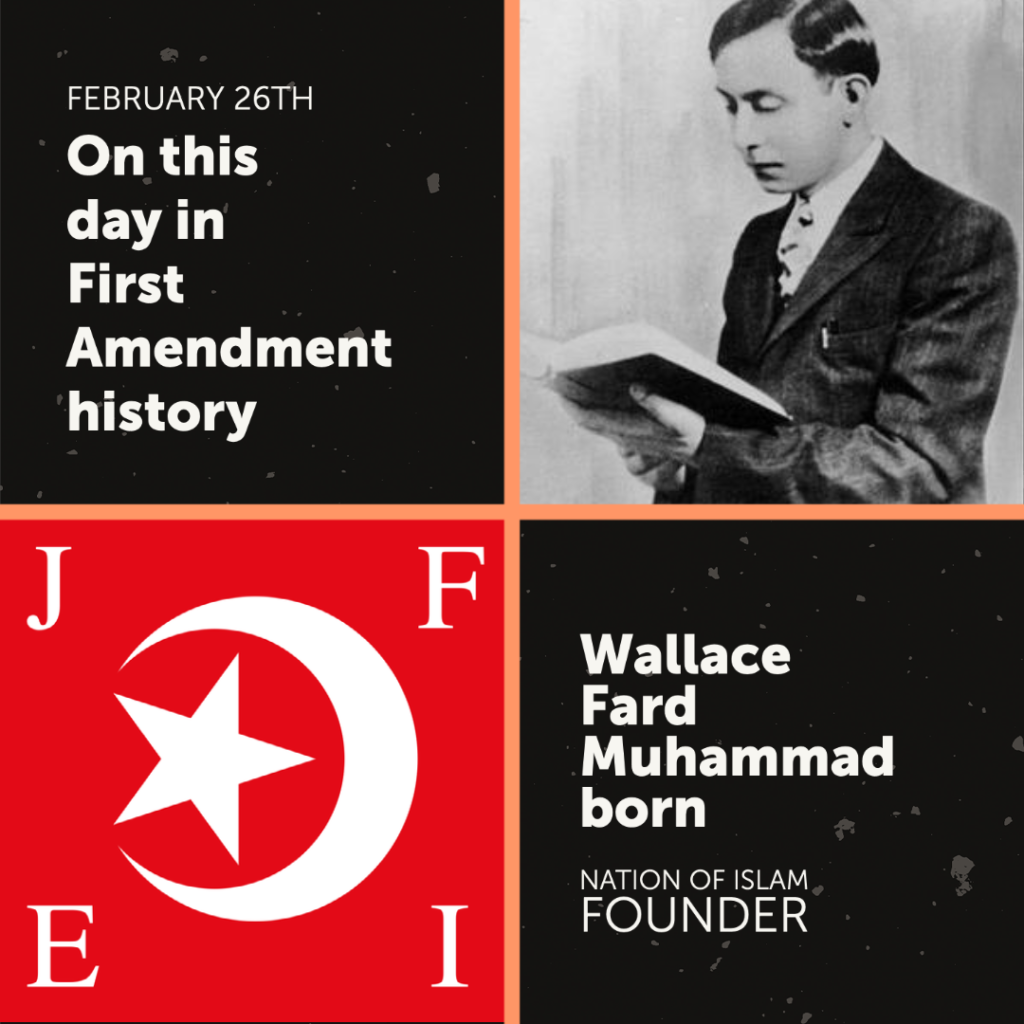
2/26/1877 – On this day in First Amendment history, religious and political activist Wallace Fard Muhammad was born.
Originally born in Mecca in what is today Saudi Arabia, Fard immigrated to the US sometime prior to 1930. He arrived in Detroit and sold silks door to door in African American neighborhoods, regaling customers with stories of his homeland. Fard described it as a utopia, largely due to the Islamic faith the people practiced.
That same year, Fard founded the Nation of Islam (NOI), a new African American political and religious movement. The goal of the NOI was to “teach the downtrodden and defenseless Black people a thorough Knowledge of God and of themselves, and to put them on the road to Self-Independence with a superior culture and higher civilization than they had previously experienced.” Fard’s teachings appealed to a disenfranchised community suffering from the Great Depression, and within three years the movement grew to include nearly 9,000 members, mostly in Detroit and Chicago.
Fard disappeared in 1934; while his leadership was short-lived, his legacy lives on. Today, the NOI’s membership is estimated to be between 20,000 – 50,000 people. Past adherents have included Malcolm X, Muhammed Ali, and Huey P. Newton.
The NOI is criticized for its anti-Semitic, racist, and anti-LGBTQ attitudes, and is designated as a hate group by the Southern Poverty Law Center.
In the Nation of Islam, today is called Saviour’s Day in honor of Fard.


